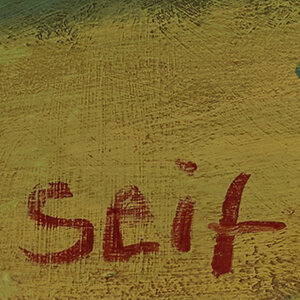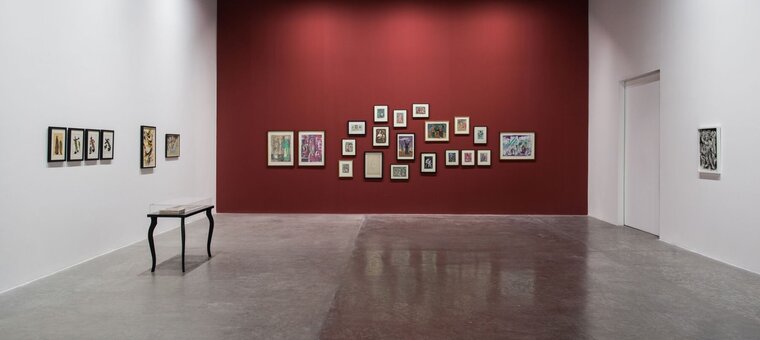


Last updated on Mon 15 September, 2014


WORKS ON PAPER: HIKAYAT
September 15 – October 26, 2014
Green Art Gallery
Green Art Gallery is pleased to announce Works on Paper: Hikayat, an exhibition that brings together over 50 works on paper by Modern Arab artists including Khouzayma Alwani, Mahmoud Hammad, Adham Ismail, Jamil Molaeb, Fateh Moudarres, Aref El Rayess, Khaldoun Shishakly, Seif Wanly and Elias Zayat. Taking storytelling as its main theme, the exhibition brings together works that offer a glimpse of drawing’s potential to make cultural, social, and political proposals or stories, through diverse formal processes.
Drawing is a medium that offers an intimate and open field for imaginative elaboration, in which concepts and ideas can emerge and change with relative ease. Uninhibited by the obligation to create a finished and independent object, as is traditionally associated with painting and sculpture, drawing as a medium lends itself readily to the theoretical and the experimental. For Fateh Moudarres (1922-1999, Syria), drawing offered precisely these possibilities. His representational language was engaged with mythology, religion and popular lore as well as a deep political engagement. An accomplished writer and poet, his “dessins” were also featured in several of his published short stories. Moudarres was once quoted: “It looks childish, but it is not childish. In my paintings one can see, how much I love human beings, in my art I stand near them, when the power of fate and oppressive structures beset them”. One can say the same for the set of drawings presented in this exhibition.
Another artist who has been throughly engaged with mythology is the Syrian artist Elias Zayat (b. 1935). Considered among the great modern artists in Syria, Zayat has had a long and rich career in painting and drawing over many decades. Known for his dramatic portraiture of mankind, his practice has been thoroughly engaged with the visual legacy of mythology, ancient civilizations and religions in the region. Figures intertwine, almost floating, while recurring images of faces, some classical, others saintly and yet others tortured, recall Zayat’s other endeavor – conservationist and restorer of orthodox icons.
For many artists of that generation, storytelling included the representation of the traditional rural life they were witnessing. This is true of Lebanese artist Jamil Molaeb’s (b. 1948) works, which were inspired by the landscapes he saw in the mountains of Lebanon and other sceneries from the traditional life of different Arab communities, depicting in his own way the villages, cities, fields and the people in their daily life.
Similar to Molaeb, the Syrian master Mahmoud Hammad (1923 - 1988, Syria) also recounted rural Syrian life, earlier in his career. Although he has been widely known for his late Abstract Calligraphic period (during the period 1964 - his death in 1988), in which the Arab script and letters became the main element, Hammad’s earlier work are of equal importance. Upon his return from Rome, he moved to Daraa where he lived for two years and started a series of paintings depicting the social scenes of the Southern area of Horan (Daraa). During that period, Hammad’s central theme was the concept of the family, in addition to the role of the mother. He was also concerned with the political landscape during that period such as February 1958, a work through which he evoked the union between Egypt and Syria by depicting the metaphorical birth of the two nations' child and at the same time, alluded to the Palestinian cause in many of his works amongst which A Girl from Horan, Wounded and Exile. In this exhibition we present Hammad’s works on paper from the Horan period, most of which became studies for much larger paintings, and many of which have never been shown to the public.
The region’s political turmoils in the 70‘s and 80‘s are portrayed by both Khouzayma Alwani (b.1934, Syria) and Aref el Rayess (1928 - 2005, Lebanon). Alwani’s delicate horrors are so exquisite they beguile the viewer into fascination with intricate imagery. Following the Hama Massacre of 1981, his work revolved around the world as a big dramatic theater of monsters and beasts, in a tacit allusion to the Syrian society in a state of devastation.
As for Aref El Rayess, the works included in the exhibition belong to a series of drawings he produced in the early seventies to denounce the corruption he was witnessing within the political circles governing the Middle East after the Cairo accord in 1969 and the 1973 Arab Israeli war. For El Rayess, it is as if the leaders and politicians were gambling our destinies through fishy manipulations and tacit agreements, hence jeopardizing the ideals of the revolution his generation firmly believed in and fought for. The age of deceit has started, and the political scene in the Arab world seems like a big farce.
The theatrical and the sublime is also present in the work of Egyptian artist Seif Wanly (1906 - 1979). The exhibition includes several works on paper in which he portrayed society’s more esoteric dimensions, featuring medieval traditions, circus acrobats and ballet dancers.
Storytelling is an essence of Arab culture and has transcended generations of artists from modern masters to the younger generation of today. Included in the exhibition is a rare account of 500 works on paper by a Syrian artist, Khaldoun Sheishakly, who has spent his entire life drawing and documenting 500 Damascene professions in intricate detail. Shops and Vendors of the Past represents an important history of storytelling and life in Syria and summarizes the artists’ needs to carve a cultural identity that reflected the groundbreaking social and political changes that were taking place at that time.
Join us in our endless discovery of modern and contemporary Arab art